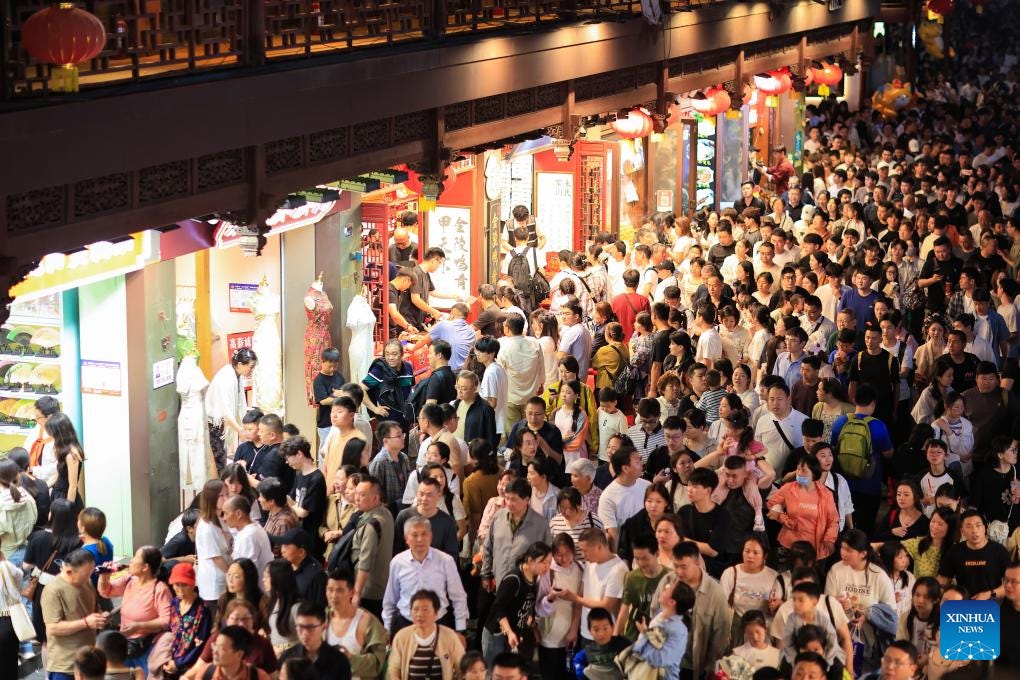Growth Dragons Weekly: Trade Talks Set, Travel Surges, Rates Cut — While Alibaba x RedNote, Geely x Zeekr, Uber x Pony.ai
What happened in China this week:
China’s Labour Day Travel Boom, Rate Cuts, and US Trade Talks
Alibaba Reloads: RedNote, Taobao, and Ele.me in Full Sync for 618
Geely Moves to Take Zeekr Private and Consolidate Its EV Empire
Uber Taps Pony.ai to Launch Robotaxis in the Middle East
#1 China’s Labour Day Travel Boom, Rate Cuts, and US Trade Talks
China’s recent Labour Day holiday offered a glimpse into the country’s economic pulse — a mix of resilient domestic demand, cautious consumer sentiment, and a policy machine working hard to keep the recovery on track.
The five-day break from May 1 to 5 saw strong travel and retail activity, both within China and across borders. Locals made 314 million domestic trips, up 6.4% from last year, and spent ¥180.3 billion ($25 billion), 8% more than in 2023. Trains were packed, highways jammed, and tourist spots overflowing — signs that leisure and consumption are alive and well.
Even tech showed up. Suzhou used AI to help with route planning, and Sichuan rolled out robots to assist travellers — subtle nudges toward China’s broader digital transformation. But beneath the surface, there’s still some weakness: per capita spending is still nearly 5% below pre-COVID levels. People are spending, but carefully.
How People Traveled Tells Us More
Travel patterns are changing. Cross-provincial trips jumped over 20%, but many opted for value-for-money experiences. Visitor numbers rose faster than revenue, suggesting a shift toward budget travel. Demand also spilled into lower-tier cities and rural areas, with family trips, pet-friendly stays, and long-term car rentals gaining traction.
International travel picked up too. There were 10.9 million inbound and outbound trips, a 28.7% increase year-on-year. China’s visa-free policies and instant tax refunds helped attract 380,000 foreign visitors — up 72.7% from last year.
Governments helped too. Local authorities issued vouchers and subsidies to spur tourism spending. Some sectors benefited — electronics and sporting goods did well — while others like cinema suffered. Box office sales fell over 50%, highlighting the uneven nature of the recovery.
Monetary Policy: Beijing Steps On the Gas
On the policy front, China is going all out. The PBOC cut the reserve requirement ratio (RRR) by 0.5 percentage points, freeing up RMB 1 trillion in long-term liquidity. It also trimmed the 7-day reverse repo rate to a record low of 1.4%, a clear message: lower borrowing costs and more lending.
Housing loans for first-time buyers saw rates drop to 2.6%, potentially saving households RMB 20 billion in interest annually. The central bank also scrapped RRR requirements for non-bank institutions in auto finance, aiming to boost credit access in key consumer sectors.
To support capital markets, the PBOC merged two RMB 800 billion programs and launched a new RMB 500 billion relending facility targeted at service and elderly care industries — two sectors expected to underpin future demand.
These moves follow April’s Politburo meeting, which emphasized a “proactive” stance in driving growth and reviving confidence.
On Trade Talks and Tariffs
At the same time, Vice Premier He Lifeng set to meet American officials in Switzerland this weekend.
The meeting matters — but we’re staying neutral on the outcome. Some speculate the U.S. may cut tariffs on China by 50%. That’s a big if. It doesn’t quite line up with Trump’s campaign theme of reshoring manufacturing. So while a tariff cut could spark short-term market optimism, we’d temper expectations that the US-China relationship is unlikely to turn cordial.
In short, China’s approach is clear: stimulate domestic demand, support innovation, and manage external risks — all while navigating a fragile but still-growing economy.





